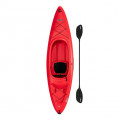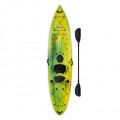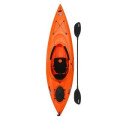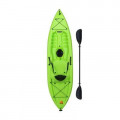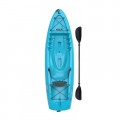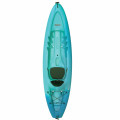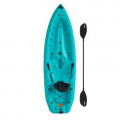Founded in 2002, Emotion is known for making budget-friendly recreational sit-inside and sit-on-top kayaks. In 2011, the Emotion Kayaks brand was purchased by Lifetime products, creators of basketball nets, sheds and other outdoor equipment. The merger combined Emotion’s knowledge of kayak design with Lifetime’s robust plastic manufacturing processes to improve their kayaks.
Today, Emotion kayaks are made under the Lifetime label. Many Emotion classics continue to be available under the Lifetime label—for example, the Emotion Stealth Anger Pro is now rebranded as the Lifetime Angler Pro. With Lifetime products, you’re still getting the best Emotion kayak shapes and designs, just under a new name.
Emotion (and Lifetime) kayaks target beginner paddlers who do not want to spend a ton of money on their first kayak or paddlers who want a bare-bones boat that can get them out on calm, sheltered water. They are classified as recreational kayaks. “Rec boats,” as they’re sometimes called, are characterized for their wide, flat bottoms and relatively short lengths, often 12 feet or less.
Most people will quickly grasp the basics of paddling in a recreational kayak, whereas longer, narrower sea kayaks can feel unstable or difficult to control for someone new to the sport. Recreational kayaks’ short length also means they are easy to carry, store and transport.
If this is what you’re looking for, or you want to learn more, read on for advice on buying new and used Emotion kayaks.
Top picks: Best Emotion Kayaks for 2024
The following Emotion and Lifetime kayaks have received the highest star ratings by reviewers in our Paddling Buyer’s Guide. See and review all Emotion and Lifetime kayaks here.
Best Emotion and Lifetime Kayaks
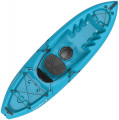
Spitfire 9
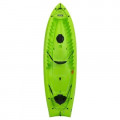
Kokanee 106

Spitfire 8
Shop Emotion and Lifetime Kayaks
Our Paddling Buyer’s Guide features every Emotion and Lifetime kayak on the market. You can choose to filter Emotion and Lifetime kayaks by type, size and application. Then, click on specific models to see specs, prices, reviews and where to buy. There are also links to buy the kayaks directly, or to find a dealer nearby.
Shop by type
Shopping for a used Emotion kayak?
You’re likely to find more used Emotion kayaks than new ones, as many models are now made under the Lifetime brand. Choosing to buy a used kayak is an excellent way to save money, but you’ll want to check the boat over carefully before committing to a purchase. This is especially true with Emotion kayaks, as some replacement parts may not be available.
Emotion kayaks are made from rotomolded plastic, which is incredibly resilient and durable. Check the hull (bottom) and deck (top) of the kayak for scrapes and cuts. Scratches that don’t pierce the hull are generally superficial. If you’re handy, deeper gouges can be mended by using a polyethylene repair kit.
The most common damage you’ll find with rotomolded kayaks is that their shape warps. Known as “oil-canning”, the most likely spot for this warping to happen is on the hull below the cockpit (seating area). Warping is most often the cause of UV damage from improper storage (long-term exposure to direct sunlight) or improper transport (over tightening tie-downs). Sometimes oil-canning can be mitigated by warming the kayak and reshaping it, but it will affect the boat’s performance if it is too warped.
The buckles, straps and seating of budget Emotion recreational kayaks are often the first things to fail. Many of these parts are plastic and can be replaced with hardware store equipment, or by contacting Lifetime for substitute parts.
The only way to fully appreciate the comfort and performance of a kayak is to try it before committing to a purchase. Arrange a meeting place with the seller that allows you to take a few moments on the water. Bring your usual paddle and dress in what you plan to wear while paddling. With a sit-inside kayak, be sure to assess how easy the boat is to enter and exit.
For more tips on what to look for when selecting a used kayak, read our article How To Buy A Used Kayak.
Emotion Kayak buying advice
Emotion kayaks are budget-friendly for people who want to get into kayaking without the significant investment that comes with high-end gear. These boats are intended for casual use on sheltered water, like at the cottage, campground or local wetland. Their basic design means that there are fewer moving parts to break.
It’s important to note that these kayaks are not suitable for open water or rough conditions. Without a watertight bulkhead (interior wall that creates separate flotation chambers within the hull), Emotion recreational kayaks will sink if the cockpit fills with water. If you are looking to explore further or paddle in rougher waters, look toward a touring kayak. But for general use on gentle waters, Emotion kayaks are available for a range of needs for paddlers of all sizes.
The initial choice for a recreational kayak buyer is deciding between a sit-inside or sit-on-top. Sit-inside kayaks are a good stepping stone for paddlers who wish to advance their skills or progress toward a longer touring kayak. As their name implies, the paddler sits inside the cockpit, with their legs covered by the deck. Some sit-inside recreational kayaks can also be equipped with a nylon sprayskirt that forms a seal around the paddler and shelters the cockpit from splashing waves, precipitation and wind.
With their open decks and wide, stable designs, sit-on-tops are even more beginner-friendly. Getting on and off requires less technique than entering or exiting a sit-inside kayak. Larger paddlers may feel more comfortable and less confined by the open deck layout. Many fishing kayaks are also sit-on-tops, as it is easier to access gear, cast and land fish.
With a bit of luck, you might track down an Emotion kayak online that suits your needs, but you likely won’t find it in any stores nearby. Instead, check for Lifetime kayaks—the model you are looking for may be available under the new parent company name. The general design of Emotion kayaks is not particularly ground-breaking or exclusive to the company. If you are looking for a cheap, stable kayak with no frills, Emotion, Lifetime, Perception and Sun Dolphin are all fairly equivalent options.
The best advice we can offer is to always test paddle before buying any boat. Of course, that’s a challenge at most of the big box outlets where many recreational kayaks are sold. Try to borrow an Emotion kayak from a friend for a test paddle in real-world conditions. The more time you can spend on the water in a similar style of kayak, the better the purchasing decision you will make.
Here are answers to some of the most common online questions about Emotion kayaks.
-
Are Emotion kayaks good?
Emotion kayaks are good entry-level recreational kayaks. You get a craft that is intuitive to use, stable and durable for a reasonable price.
-
What happened to Emotion kayaks?
In 2011, Emotion was purchased by Lifetime products. This began a gradual shift towards rebranding Emotion kayaks under the Lifetime label. Emotion’s design team went to work for Lifetime, so newer Lifetime kayaks still have Emotion’s fingerprints on them.
-
Emotion kayak models
The Emotion Tide 103 kayak is still made, while other popular models like the Stealth Angler Pro have adopted the Lifetime label.
-
Where are Emotion kayaks made?
Emotion kayaks are made in the Lifetime factory, located in Utah.
-
Emotion kayak price
Emotion kayaks are priced in the low-to-mid range. Used Emotion kayaks should be priced no higher than $400. New Emotion kayaks, like the Emotion Tide 103, are slightly more expensive than basic Lifetime models but still on the lower end of the rec kayak spectrum.
-
Emotion kayak weight limit
Emotion kayak’s weight limit varies depending on the model, but recreational kayaks tend to have generous weight capacities. Most Emotion kayaks will have a maximum capacity of 250 pounds, except the youth kayaks, which are 130 pounds.
-
How much does an Emotion kayak weigh?
The weight of an Emotion kayak depends on its length, with most Emotion kayaks weighing around 40–50 pounds. Emotion kayaks are made from rotomolded polyethylene plastic, which is one of the heavier kayak materials. If you’re looking for a lighter kayak of the same size, consider a kayak made from thermoformed plastic or fiberglass (although these materials will cost significantly more than an Emotion kayak).
-
Emotion kayak warranty
New Emotion kayaks come with a one-year limited warranty under Lifetime.
Emotion kayak comparison
-
Pelican vs Emotion kayak
Pelican is a behemoth in the kayak world, producing dozens of different models. The kayaks Pelican makes range from rotomolded ones similar in price and target demographic to Emotion kayaks, to more expensive lightweight recreational kayaks. Emotion/Lifetime sticks to rotomolded budget kayaks. If you are looking for a simple, cheap kayak for short outings, Emotion is a fine choice (if you can find one).
However, you’ll find a far greater selection of new Pelican kayaks available today; this widespread availability makes them a better choice for many beginner paddlers. Also, many Pelican kayaks are made of super durable RAM-X plastic, which is worth the nominal extra expense for those looking to store their kayak outdoors and exposed to the elements.
-
Lifetime vs Emotion kayak
New Lifetime and Emotion kayaks are essentially the same boats—with a few caveats. The Emotion Tide 103 is slightly more expensive than similarly-sized Lifetime models, mainly because of the “skeg wheel” addition. This feature has two purposes: helping with tracking and making transport more accessible.
The skeg is a fin that extends below the back (stern) of the kayak to prevent the kayak from turning side-to-side with each paddle stroke. On the Emotion Tide 103 kayak, the skeg is also a wheel. It rolls on smooth surfaces for easy transport with just one person across parking lots or down boat ramps.
Emotion kayak reviews
Reviews are a valuable tool that helps you learn more about different types of kayaks, and see if they match the kind of kayaking you plan to do. Look no further than our expert reviews below for solid advice in selecting and purchasing an Emotion kayak.
Coming soon



